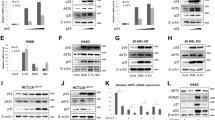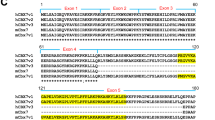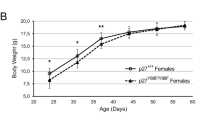Abstract
c-Abl is a tyrosine kinase that can act as a regulator of cell growth and apoptosis in response to stress. Using cell lines expressing c-Abl in an inducible manner, we identified genes whose expression was regulated by c-Abl kinase activity. Microarray analysis indicated that Early Growth Response-1 (EGR1) gene expression is induced by c-Abl kinase activity, which was confirmed at the message and protein levels. Promoter mapping experiments revealed that c-Abl utilizes three distal serum response elements (SREs) in the EGR1 promoter, which are transactivated by mitogen/extracellular receptor kinase (MEK/ERK) signaling. PD 95089, a specific inhibitor of MEK/ERK signaling, attenuated c-Abl-mediated upregulation of EGR1 expression in a dose-dependent manner. Similar results were obtained by using a dominant-negative mutant of mitogen/extracellular kinase. Significantly, hydrogen peroxide-induced EGR1 expression appears to be mediated by c-Abl, as cells expressing dominant negative c-Abl, and c-Abl−/− murine embryonic fibroblasts, are completely defective in hydrogen peroxide-induced EGR1 expression. In addition, c-Abl-induced apoptosis is partially mitigated by EGR1 activity, as cells devoid of EGR1 expression undergo reduced rates of c-Abl-induced apoptosis. Together, these results indicate that c-Abl promotes the induction of EGR1 through the MEK/ERK pathway in regulating apoptotic response to oxidative stress.
This is a preview of subscription content, access via your institution
Access options
Subscribe to this journal
Receive 50 print issues and online access
$259.00 per year
only $5.18 per issue
Buy this article
- Purchase on Springer Link
- Instant access to full article PDF
Prices may be subject to local taxes which are calculated during checkout





Similar content being viewed by others
References
Alessi DR, Cuenda A, Cohen P, Dudley DT and Saltiel AR . (1995). J. Biol. Chem., 270, 27489–27494.
Baskaran R, Wood LD, Whitaker LL, Canman CE, Morgan SE, Xu Y, Barlow C, Baltimore D, Wynshaw-Boris A, Kastan MB and Wang JY . (1997). Nature, 387, 516–519.
Brasher BB and Van Etten RA . (2000). J. Biol. Chem, 275, 35631–35637.
Christy B and Nathans D . (1989). Mol. Cell Biol., 9, 4889–4895.
Chuaqui RF, Bonner RF, Best CJ, Gillespie JW, Flaig MJ, Hewitt SM, Phillips JL, Krizman DB, Tangrea MA, Ahram M, Linehan WM, Knezevic V and Emmert-Buck MR . (2002). Nat. Genet., 32 (Suppl), 509–514.
Cibelli G, Policastro V, Rossler OG and Thiel G . (2002). J. Neurosci. Res., 67, 450–460.
Daniel R, Cai Y, Wong PM and Chung SW . (1995). Oncogene, 10, 1607–1614.
Datta R, Rubin E, Sukhatme V, Qureshi S, Hallahan D, Weichselbaum RR and Kufe DW . (1992). Proc. Natl. Acad. Sci. USA, 89, 10149–10153.
Datta R, Taneja N, Sukhatme VP, Qureshi SA, Weichselbaum R and Kufe DW . (1993). Proc. Natl. Acad. Sci. USA, 90, 2419–2422.
Goga A, Liu X, Hambuch TM, Senechal K, Major E, Berk AJ, Witte ON and Sawyers CL . (1995). Oncogene, 11, 791–799.
Gu J, Chen D, Rosenblum J, Rubin RM and Yuan ZM . (2000). Mol. Cell Biol., 20, 1243–1253.
Hallahan DE, Sukhatme VP, Sherman ML, Virudachalam S, Kufe D and Weichselbaum RR . (1991). Proc. Natl. Acad. Sci. USA, 88, 2156–2160.
Houslay MD and Kolch W . (2000). Mol. Pharmacol., 58, 659–668.
Jones N and Agani FH . (2003). J. Cell Physiol., 196, 326–333.
Kaufmann K, Bach K and Thiel G . (2001). Biol. Chem., 382, 1077–1081.
Khachigian LM, Lindner V, Williams AJ and Collins T . (1996). Science, 271, 1427–1431.
Khachigian LM, Williams AJ and Collins T . (1995). J. Biol. Chem., 270, 27679–27686.
Kharbanda S, Pandey P, Jin S, Inoue S, Bharti A, Yuan ZM, Weichselbaum R, Weaver D and Kufe D . (1997). Nature, 386, 732–735.
Kharbanda S, Pandey P, Yamauchi T, Kumar S, Kaneki M, Kumar V, Bharti A, Yuan ZM, Ghanem L, Rana A, Weichselbaum R, Johnson G and Kufe D . (2000). Mol. Cell Biol., 20, 4979–4989.
Krones-Herzig E, Adamson E and Mercola D . (2003). Proc. Natl. Acad. Sci. USA, 100, 3233–3238.
Marais R, Wynne J and Treisman R . (1993). Cell, 73, 381–393.
Nair P, Muthukkumar S, Sells SF, Han SS, Sukhatme VP and Rangnekar VM . (1997). J. Biol. Chem., 272, 20131–20138.
Park JO, Lopez CA, Gupta VK, Brown CK, Mauceri HJ, Darga TE, Manan A, Hellman S, Posner MC, Kufe DW and Weichselbaum RR . (2002). J. Clin. Invest., 110, 403–410.
Plattner R, Kadlec L, DeMali KA, Kazlauskas A and Pendergast AM . (1999). Genes Dev., 13, 2400–2411.
Sakamoto KM, Bardeleben C, Yates KE, Raines MA, Golde DW and Gasson JC . (1991). Oncogene, 6, 867–871.
Shaw PE, Schroter H and Nordheim A . (1989). Cell, 56, 563–572.
Stork PJ and Schmitt JM . (2002). Trends Cell Biol., 12, 258–266.
Sun X, Majumder P, Shioya H, Wu F, Kumar S, Weichselbaum R, Kharbanda S and Kufe D . (2000). J. Biol. Chem., 275, 17237–17240.
Svaren J, Ehrig T, Abdulkadir SA, Ehrengruber MU, Watson MA and Milbrandt J . (2000). J. Biol. Chem., 275, 38524–38531.
Tanis KQ, Veach D, Duewel HS, Bornmann WG and Koelske AJ . (2003). Mol. Cell Biol., 23, 3884–3896.
Thiel G and Cibelli G . (2002). J. Cell Physiol., 193, 287–292.
Virolle T, Adamson ED, Baron V, Birle D, Mercola D, Mustelin T and de Belle I . (2001). Nat. Cell Biol., 3, 1124–1128.
Yuan ZM, Huang Y, Ishiko T, Kharbanda S, Weichselbaum R and Kufe D . (1997). Proc. Natl. Acad. Sci. USA, 94, 1437–1440.
Acknowledgements
We thank Dr Dan Mercola (Sidney Kimmel Research Center, San Diego, CA, USA) for providing EGR1 null and WT MEFs, Dr Kathleen Sakamoto (Department of Pediatrics, Division of Hematology/Oncology, School of Medicine, Los Angeles, CA, USA) for providing the EGR1 promoter, and Dr Anthony Koleske (Dept. Molecular Biophysics and Biochemistry, Yale University, New Haven, CT, USA) for providing Abl null MEFs. We also thank Claire Bailey (Center for Genomics Research, Harvard University, Cambridge, MA, USA) for microarray and Q-RT-PCR analysis, and Colleen Dionne for manuscript preparation and submission. This work was supported by NIH grant R29 CA85679.
Author information
Authors and Affiliations
Corresponding author
Rights and permissions
About this article
Cite this article
Stuart, J., Kawai, H., Tsai, K. et al. c-Abl regulates Early Growth Response Protein (EGR1) in response to oxidative stress. Oncogene 24, 8085–8092 (2005). https://doi.org/10.1038/sj.onc.1208953
Received:
Accepted:
Published:
Issue Date:
DOI: https://doi.org/10.1038/sj.onc.1208953
Keywords
This article is cited by
-
Regulatory mechanism of downregulation of SOD1 expression on cardiomyocyte function
Sleep and Breathing (2023)
-
Involvement of c-Abl Kinase in Microglial Activation of NLRP3 Inflammasome and Impairment in Autolysosomal System
Journal of Neuroimmune Pharmacology (2017)
-
Silica Nanoparticles Induced Metabolic Stress through EGR1, CCND, and E2F1 Genes in Human Mesenchymal Stem Cells
Applied Biochemistry and Biotechnology (2015)
-
A non-Smad mechanism of fibroblast activation by transforming growth factor-β via c-Abl and Egr-1: selective modulation by imatinib mesylate
Oncogene (2009)
-
A network of p73, p53 and Egr1 is required for efficient apoptosis in tumor cells
Cell Death & Differentiation (2007)



